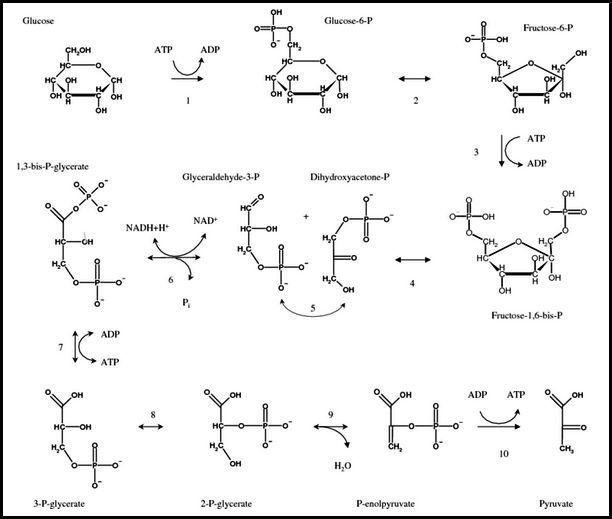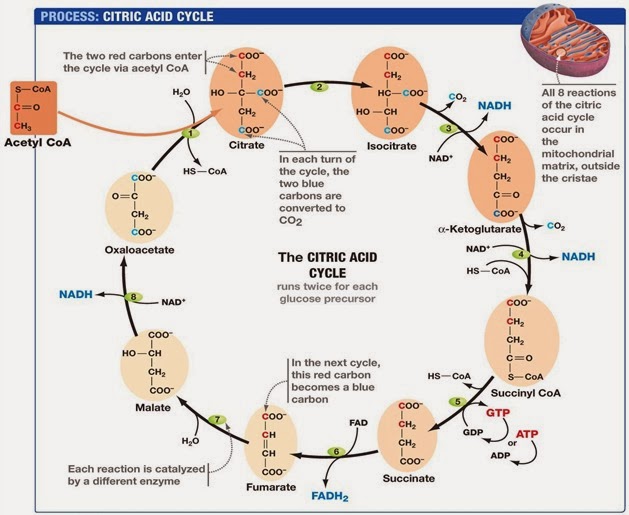Respiration is a process of biological oxidation where oxygen is utilized and carbon dioxide is released for the purpose of releasing energy.
Mechanism of Respiration Involves:
- Glycolysis
- Anaerobic break down of Pyruvic acid
- Krebs cycle: Aerobic break down of Pyruvic acid
- Electron transport system
- Terminal oxidation and Oxidative phosphorylation.
- Pentose phosphate pathway
Glycolysis or Embden - Meyerhof - Parnas (EMP) pathway: The sequence of chemical reactions by which one molecule of glucose is converted to two molecules of pyruvic acid is termed as glycolysis. It take place in the cytoplasm and it does not require oxygen. Hence glycolysis is an anaerobic process. It is also known as Embden - Meyerhof - Parnas (EMP) pathway.
Krebs Cycle or Citric Acid Cycle or Tricarboxylic acid cycle (TCA cycle): The entire Krebs cycle occurs in side the mitochondria. The oxidation of pyruvic acid into carbon dioxide and water is called Krebs cycle. It was discovered by Krebs in 1936. This cycle is also called citric acid cycle, because the cycle begins with the formation of citric acid. The citric acid is a carboxylic acid containing three COOH groups. Hence this cycle is also called tricarboxylic acid cycle (TCA cycle). It is an aerobic process.
Glycolysis vs Krebs Cycle
Glycolysis
|
Krebs cycle
|
| It occurs inside the cytopasm. | Krebs cycle operates inside mitochondria. |
| The process is common to both aerobic and anaerobic mode of respiration. | It occurs only in aerobic respiration. |
| It is first step of respiration in which glucose is broken down to the level of pyruvate. | Krebs cycle is the second step in respiration. |
| It degrades a molecule of glucose into two molecules of an organic substance, pyruvate. | It degrades pyruvate completely into inorganic substances (CO2 + H2O). |
| Glycolysis consumes 2 ATP molecules for the initial phosphorylation of substance molecule. | It does not consume ATP. |
| In glycolysis, one glucose molecule liberates 4 ATP molecules through substrate level phosphorylation. | In Krebs cycle, two acetyl residues liberates two ATP or GTP molecules through substrate level phosphorylation. |
| Net gain is two molecules of NADH and two molecules of ATP for every molecule of glucose broken down. | Krebs cycle produces six molecules of NADH, and 2 molecules of FADH2 for every two molecules of acetyl CoA oxidized by it. |
| The net gain of energy is equal to 8 ATP. | The net gain of energy is equal to 24 molecules of ATP. |
| No carbon dioxide is evolved in glycolysis. | Carbon dioxide is evolved in Krebs cycle. |
| It is not connected with oxidative phosphorylation. | It is connected with oxidative phosphorylation. |
| Oxygen is not requires for glycolysis. | Krebs cycle uses oxygen as terminal oxidant. |


Thank you! The glycolysis vs krebs cycle was just what I needed.
ReplyDeletethanx
ReplyDeleteReally helpful
ReplyDeleteOtha sunni
ReplyDeletePost a Comment
We Love to hear from U :) Leave us a Comment to improve this site
Thanks for Visiting.....